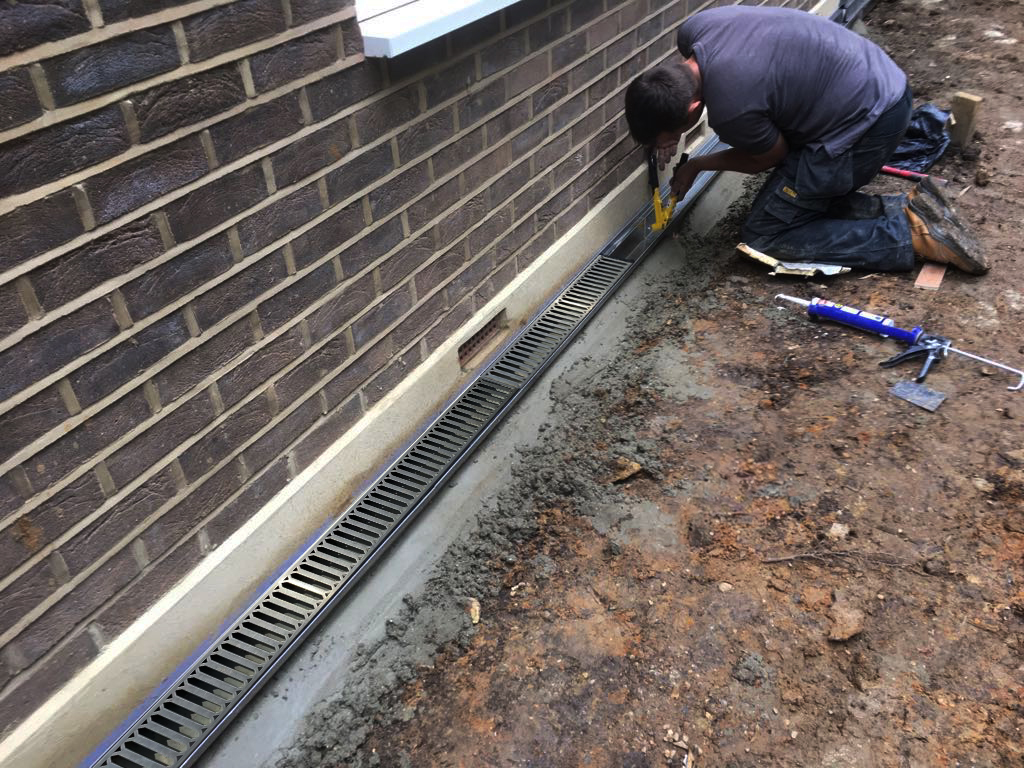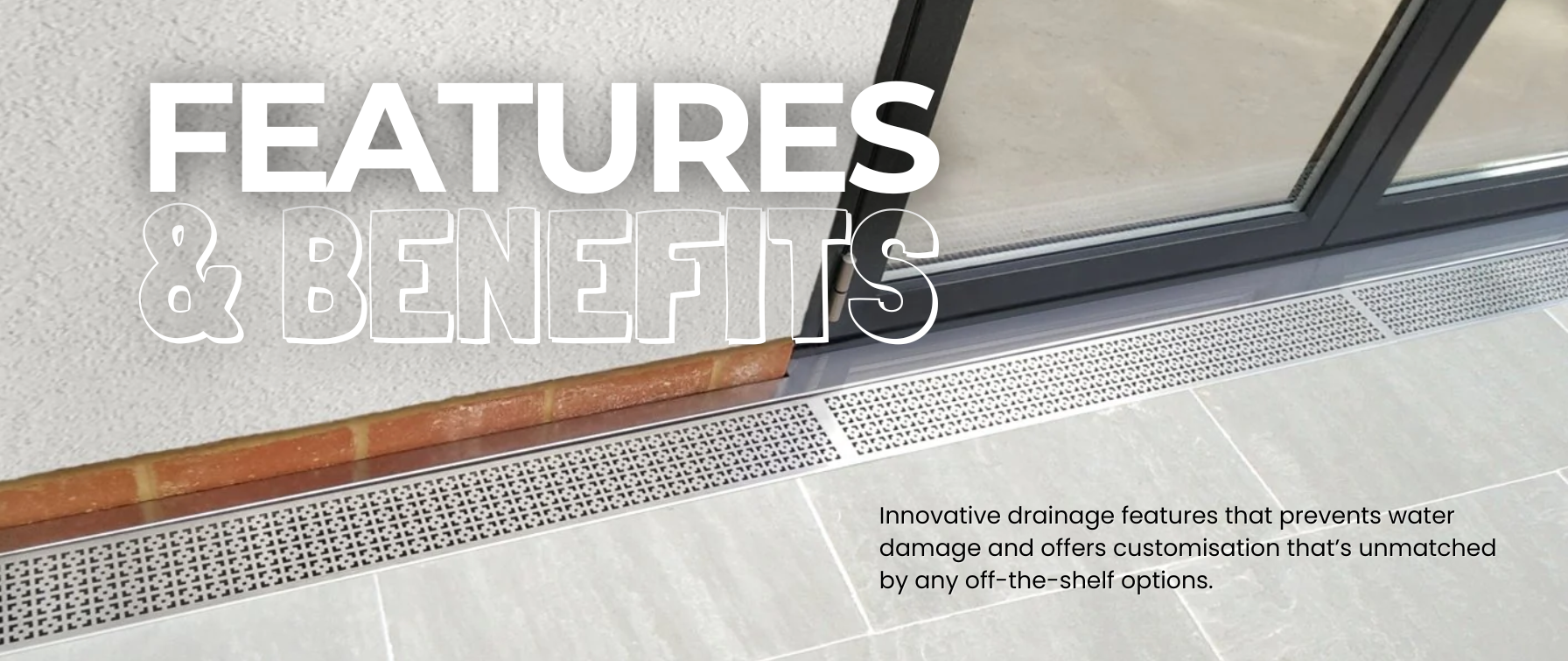
Features & Benefits of Aqualevel
We specialise in the innovation, design, and production of cutting-edge drainage products that not only deliver exceptional functionality but also elevate the aesthetic appeal of any project to a new pinnacle. Our esteemed Aqualevel system, recipient of multiple accolades, empowers you with the flexibility to customise and craft a truly distinctive design tailored to your project’s specifications.
Aqualevel was designed to be fitted prior to an installation or along with the door install, however we have the only drain system that can be retrofitted after the doors have already been put in. Off-the-shelf threshold drain systems are typcially not fit for purpose as they cannot be adapted to work with all the site variables, that then allow water to enter the fabric of the building.
-
Uncompromised True Level Access Drain
The only full threshold drain that provides a true level access drain without compromise, for all flush level or semi-flush door thresholds.
-
Versatile Installation Solutions
Designed for new installs or retrofitted installations if the doors are already fitted.
-
Efficient Water Infiltration Protection
An exceptionally efficient flush threshold drain, meticulously designed to offer thorough safeguarding against water infiltration.
-
Seamless Elevation
Operates seamlessly across all settings and elevations, spanning from ground level and basements to balconies and rooftops of varying designs.
-
Comprehensive Water Management
Gathers water from three distinct sources and efficiently diverts the flow, encompassing water from rainwater harvesting systems, all managed within a single system.
-
Streamlined Door Opening Drainage
A single continuous channel drain is all that's needed to accommodate multiple door openings, seamlessly aligned along brick elevation lines with our integrated reveal infill detail.
Covers & Finishes
– Seamlessly extends around the building where paving is uniformly leveled.
– Streamlines sub-ground drainage installations, reducing build costs.
– Accommodates floor variations, threshold build-ups, and external ground level differences.
– Fully compliant with Part M Building Regulation, ensuring unrestricted access for wheelchair users.
– All channels, components, and covers crafted from recycled aluminium and stainless steel.
– Simple to specify and install with our click-and-fix modular system.
– Comprehensive range of components available, including angles, stop ends, spigot outlets, connectors, and silt/leaf boxes.
– Compatible with domestic 110mm soakaways and main drain systems for full connectivity.
– Enhance cover design and client experiences with LED lighting feature, channel light bars.
– Technical support and design services available for backup.
– Designed and manufactured in the UK, ensuring quality and reliability.
Key Considerations
The precise detailing of level thresholds poses significant challenges, often involving adherence to standard specifications indicating a 150 mm difference between the finished floor level and the external ground level. Despite these complexities, level thresholds offer a proactive solution to accommodate the needs of an aging population, promoting inclusivity within architectural designs. Additionally, they serve as a visually appealing element, seamlessly connecting indoor and outdoor spaces.
Furthermore, compliance with level threshold standards is a legal requirement for new residential constructions in the United Kingdom. This mandate applies to all external access points, including front, rear, and side entrances, as well as various door types such as sliding, bifold, French, or terrace doors, ensuring equal access for all. While not universally mandated for renovation projects by building regulations, certain local authorities may request level thresholds as a condition for extensive renovations.
Here, we will examine essential factors to consider during the design of level thresholds to prevent water ingress into the building.

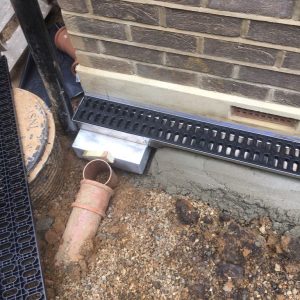
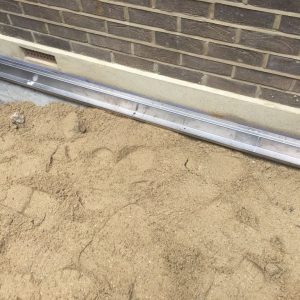
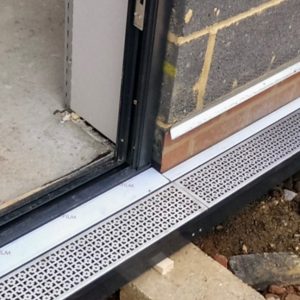
Accessible/Level Threshold
An accessible threshold is characterised by being either level or, if raised, having a total height not exceeding 15 mm, with minimal upstands and slopes, and any upstands exceeding 5 mm must be chamfered.
Building Regulation Requirements
For individual new residential constructions, compliance with Building Regulation Part M4(1) and M4(2) is mandatory. This entails ensuring all access points to the dwelling, including the entrance, garden, and any terraces, are devoid of steps. In the case of larger developments or apartment complexes, local authorities may stipulate that 10% of units comply with Building Regulations Part M4(3), ensuring full adaptability for wheelchair users.
Although compliance with these Building Regulations is not obligatory for extensions, certain Local Authorities, Building Control bodies, and/or Approved Inspectors may impose the requirement to meet Part M4(1) as a condition of planning approval, necessitating accessible entrances and exits for the property.
You can view the latest Approved Document M Building Regulations here.
Ground Floor Thresholds
Designing a level threshold involves considering various factors such as aesthetics, cost, structural integrity, site conditions, and location. Nonetheless, there are several critical aspects that all level thresholds must address.
Door Selection
When selecting a door for use in a level threshold, most manufacturers will indicate compliance with Part M of the Building Regulations. This ensures that the threshold height does not exceed 15 mm and that any upstands are no higher than 5 mm. While sliding door systems typically feature a completely level base frame, careful attention should be paid to the base frame of front and rear doors, particularly those made of timber, which may require specialised aluminum thresholds for full accessibility.
Threshold Drainage
Incorporating drainage into the threshold design is a mandatory building regulation requirement. A drain can be positioned between the sill and external landscaping, either flush with the level floor or concealed beneath finishes. Many door manufacturers offer threshold drains compatible with their door systems, facilitating the efficient drainage of water near the drain and any water that strikes the door or glass and drains through the frame.
Waterproofing
Damp proof membranes should be installed to cover the door or window frame system at the threshold point. Proper drainage should be ensured by sloping external finishes away from the drain. Additionally, the damp proof course should extend a minimum of 150 mm above ground level on either side of the threshold to prevent water ingress.
